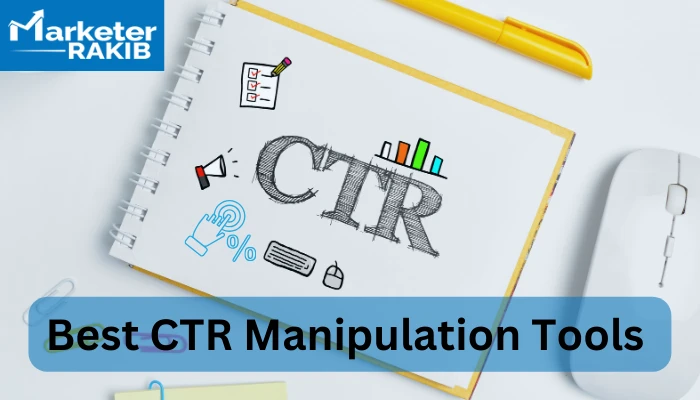Optimize Your SEO Outcomes with LinkDaddy CTR Manipulation Expertise
Optimize Your SEO Outcomes with LinkDaddy CTR Manipulation Expertise
Blog Article
How to Measure the Influence of CTR Adjustment on Your Advertising And Marketing
Comprehending the nuances of click-through price (CTR) adjustment in advertising is important for organizations striving for authentic customer engagement. By checking out essential metrics such as conversion prices and bounce rates, marketing professionals can reveal prospective disparities that may emerge from synthetic improvements.
Understanding CTR Manipulation
Comprehending CTR manipulation is crucial for marketing professionals seeking to enhance their projects and guarantee information honesty. Click-through rate (CTR) refers to the ratio of individuals who click a specific web link to the total number of customers that watch the advertisement or web content. Control of this metric can take place via various methods, including the usage of deceptive advertising techniques, click ranches, or automated crawlers. These techniques can unnaturally inflate CTR numbers, causing misdirected advertising and marketing techniques and misallocation of sources.
The ramifications of CTR manipulation extend past simple data distortion; they can undermine rely on digital advertising. When businesses rely upon inflated metrics, they may invest in inadequate projects, eventually damaging their roi. Additionally, systems might penalize marketers taking part in such practices, leading to additional ramifications for their marketing initiatives.
To successfully fight CTR manipulation, marketing professionals need to establish a detailed understanding of their data sources and analytics tools. By using innovative monitoring approaches and scrutinizing traffic sources, they can determine irregular patterns and make certain that their efficiency metrics show real individual engagement - CTR Manipulation. This alertness is important for fostering long-lasting success in a significantly competitive electronic landscape
Key Metrics to Evaluate
Reliable analysis of crucial metrics is critical for evaluating real performance of marketing projects and discovering potential CTR control. One primary statistics to think about is the Click-Through Price (CTR) itself, which stands for the ratio of individuals that click on an advertisement to the total number of users who see it. An abrupt spike in CTR might indicate manipulation, requiring additional examination.
In addition, keeping an eye on conversion prices is essential. A high CTR with a low conversion rate could indicate that the clicks are not authentic or that the targeting is misaligned (CTR Manipulation Press Release). Evaluating bounce rates can provide insight into user engagement; a high bounce rate after a click may suggest that the traffic is not quality-driven.

Tools for Measurement

Furthermore, A/B screening devices such as Optimizely or VWO can facilitate testing with numerous ad versions to identify which aspects drive greater CTR. These devices permit marketing professionals to assess real-time performance and make data-driven modifications. Social media site analytics devices, like Hootsuite or Sprout Social, can also contribute in recognizing CTR within social systems, supplying understandings right into target market behavior and interaction fads.
Moreover, warmth mapping tools, such as Hotjar, can reveal just how individuals connect with advertisements, helping to determine where improvements can be made. Integrating these devices creates a robust dimension structure, making it possible for marketing experts to discern the results of CTR control properly. Eventually, the best choice of measurement devices is important for making informed advertising choices and optimizing campaign efficiency.

Reviewing Lasting Effects
One must think about the lasting impacts of CTR control on general marketing performance, as temporary gains can frequently mask much deeper implications. Over time, unnaturally inflated click-through prices may lead to lessened count on from customers and search engines alike. When individuals continuously come across deceitful methods, they may become hesitant to involve with the LinkDaddy CTR Manipulation brand name, causing lower conversion rates in the future.
Additionally, algorithm updates from systems such as Google are made to prioritize real involvement over inflated metrics. Consequently, businesses that depend on CTR manipulation might discover themselves penalized, causing a decline in organic reach and visibility. This can have a plunging effect on brand name credibility and consumer loyalty, ultimately threatening the extremely goals that the initial control sought to attain.
Moreover, the information accumulated from adjusted CTR might mislead marketing experts in their strategy growth. Counting on skewed data can result in misdirected campaigns that fail to reverberate with the target market, causing lost sources and missed out on opportunities. It is important for online marketers to assess the lasting ramifications of CTR control and focus on sustainable, honest engagement methods for lasting success.
Ethical Factors To Consider in CTR Manipulation
In the realm of digital marketing, ethical considerations surrounding CTR control are paramount. While the desire to boost click-through prices (CTR) can lead to temporary gains, the potential long-lasting repercussions on brand integrity and customer trust fund can not be overlooked.
Moreover, ethical problems reach conformity with guidelines such as the Federal Profession Compensation (FTC) guidelines, which mandate openness in advertising. Failing to stick to these requirements can subject companies to legal ramifications and damage their credibility. Marketers must take into consideration the effects of their techniques on individual experience and the wider market landscape.
Furthermore, the increase of synthetic intelligence and automation in marketing offers additional honest problems. The potential for mathematical bias or the exploitation of customer data questions concerning responsibility and fairness. Ultimately, moral advertising methods should focus on openness, honesty, and respect for the customer, cultivating lasting partnerships that transcend mere metrics like CTR. Stabilizing performance with values is vital for sustainable success in the electronic marketplace.
Conclusion
In conclusion, measuring the influence of CTR adjustment on advertising needs a detailed evaluation of crucial metrics, consisting of click-through rates, conversion prices, and bounce rates. Ultimately, a data-driven approach ensures that marketing techniques are effective and aligned with real customer communications.
Comprehending the nuances of click-through price (CTR) adjustment in advertising is necessary for services aiming for authentic user involvement.Efficient analysis of crucial metrics is crucial for evaluating the real performance of advertising and marketing campaigns and detecting possible CTR adjustment.One need to consider the lasting impacts of CTR manipulation on overall advertising and marketing efficiency, as short-term gains can often mask deeper implications.In the world of electronic marketing, honest factors to consider bordering CTR adjustment are vital.In verdict, determining the impact of CTR manipulation on marketing calls for an extensive analysis of crucial metrics, including click-through prices, conversion prices, and bounce rates.
Report this page